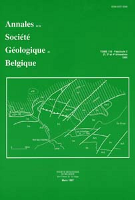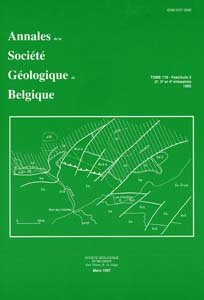- Accueil
- Volume 113 (1990)
- Fascicule 2
- La tectonique intra-katanguienne dans la région Nord-Ouest de l'Arc Lufilien (Shaba, Rép. du Zaïre)
Visualisation(s): 1260 (12 ULiège)
Téléchargement(s): 3062 (85 ULiège)
La tectonique intra-katanguienne dans la région Nord-Ouest de l'Arc Lufilien (Shaba, Rép. du Zaïre)

Résumé
Dans la région Nord-Ouest de l'Arc Lufilien, un sondage de reconnaissance géologique a été foré au coeur de l'anticlinal de Mamfwe, à l'extrémité Est du Katangien jusqu'ici considéré comme autochtone. Ce sondage remet en question la nature autochtone de cette structure. La description des unités stratigraphiques traversées établit en effet que l'anticlinal de Mamfwe constitue un important paquet de roches kundelunguiennes reposant sur du Ks-2.1 par l'intermédiaire d'une brèche tectonique. D'autre part, l'examen des données géophysiques anciennes fait ressortir la présence de fractures au sein du massif, au Sud de Kolwezi. Il en résulte une interprétation nouvelle de la tectonique intra-katangienne dans la région Nord-Ouest de l'Arc Lufilien au Shaba. Celle-ci suppose que l'ensemble du Katangien plissé observable dans ce secteur appartiendrait à la même nappe de charriage. Le Roanien de Kolwezi, Pungulume, Tombolo, etc… pourrait alors résulter d'une extrusion provoquée par le déplacement des entités kundelunguiennes charriées. Le modèle rapproche la formation de ces nappes du style tectonique habituel au Shaba, et on peut en déduire que les failles obliques à extrusion découlent de cette même tectonique.
Abstract
In the North-West district of the Lufilian Arc, a prospecting bore-hole was realized in the heart of the Mamfwe anticline, at the eastern part of the hither to regarded as autochthonal Katangan. This bore-hole begins in the Ki-1.1 («Grand Conglomérat») formation, at the base of the Lower Kundelungu Supergroup. It had to cross the Roan Supergroup and if possible, to reach the Kibaran basement. The stratigraphic succession observed proves nevertheless that the Mamfwe anticline overlaps the Upper Kundelungu Supergroup through a big tectonical friction breccia, and thus calls in question the autochthonal character of the folded Katangan in this whole district. This is supported by previous geophysical data which show unobserved faults affecting the «autochthonal» Katangan in the neighbouring South of Kolwezi. Consequently it appears that the sedimentary Katangan cover in this North-West portion of the Lufilian Arc is probably completely dislocated, and compressed against the Kibaran stop. As a result of this model, the Roanian breccia of Kolwezi, Pungulume, Tombolo, etc... was probably extruded between drifted kundelungu masses, thus was formed in the same conditions than the other Roanian breccia of the Shaban Copperbelt. Similarly, the oblique extruding faults seem resulting from the same tectonical process.
Pour citer cet article
A propos de : Jacques Cailteux
Bureau d'Etudes Géologiques, Gécamines-P.R.D., Likasi (Shaba, ZAIRE).






